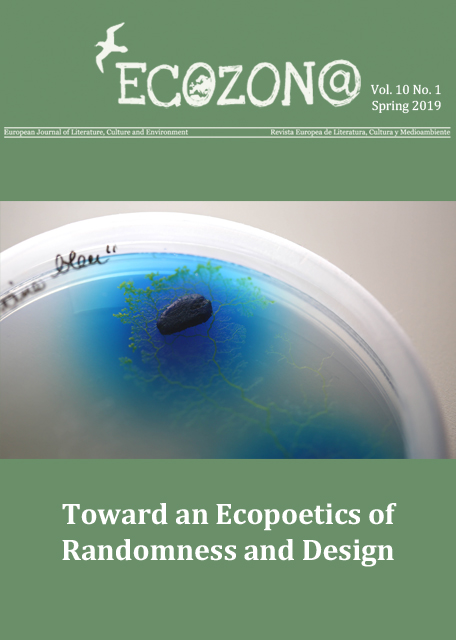<b>Toward an Ecopoetics of Randomness and Design: An Introduction</b> // Hacia una eco-poética de la aleatoriedad y el diseño: Una introducción
DOI:
https://doi.org/10.37536/ECOZONA.2019.10.1.3066Keywords:
Ecopoetics, poiesis, randomness, design, entanglement, ecotone, adaptive mapping // Ecopoética, aleatoriedad, diseño, enmarañamiento, ecotono, mapeo flexibleAbstract
What ecopoetics is and what it does, how it relates to but also exceeds ecopoetry, and the nature of its relationship to the more general poiesis (?making”) at work in the material universe remain open and thorny questions. Moreover, what are the insights from the more specialised field of experimental ecopoetry that we may bring to our understanding of ecopoetics in general, whatever the genre and material support on which environmentally-inflected poiesis deploys itself? As this Special Focus section shows, one may begin to answer such questions by taking into account notions of randomness and design, concepts that operate in experimental texts and the material universe at large, but which have not been sufficiently foregrounded in the ongoing theoretical debate on ecopoetics. Any sustained effort to understand how randomness and design permeate ecopoetics requires a vision of ecopoetics that goes beyond (eco)poetry. Providing some examples of what such a broader vision of ecopoetics might look like is also one of the goals of this Special Focus. Unfolding in three stages, this introductory essay will first map out the elements and orientations that inform the debates on ecopoetics, while also touching upon the adjacent territories of geopoetics, zoopoetics, écopoétique and Ökopoetik. A second part will meditate on the elusive concepts of randomness and design, and on how ecopoetics might be considered a form of adaptive mapping of their ever-fluid entanglement. The third part, finally, presents the contributions to this Special Focus section and surveys the different facets of the co-constitutive operations of randomness and design explored in each.
Resumen
Lo que es y hace la ecopoética, cómo se relaciona pero también supera la ecopoesía, y la naturaleza de su relación con la más general poiesis (“creación”) en el universo material siguen siendo cuestiones abiertas y espinosas. Además, ¿cuáles son las percepciones del campo más especializado de la ecopoesía experimental que podemos aplicar a nuestro entendimiento de la ecopoética en general, sea cual sea el enero y el soporte material en el que se despliega la poiesis influida por el medioambiente? Como muestra esta Sección especial, uno puede empezar a responder tales preguntas teniendo en cuenta nociones de aleatoriedad y diseño, conceptos que operan en textos experimentales y en el universo material en general, pero que no se han colocado suficientemente en un primer plano en el continuo debate teórico sobre la ecopoética. Cualquier esfuerzo continuo para entender cómo la aleatoriedad y el diseño impregnan la ecopoética requiere una visión de la ecopoética que va más allá de la (eco)poesía. Aportando algunos ejemplos del posible aspecto de esa visión más amplia de la ecopoética es también uno de los objetivos de esta sección. Desarrollada en tres pasos, este ensayo introductorio primero delineará los elementos y orientaciones que informan los debates sobre ecopoética, a la vez que abordará brevemente los campos adyacentes de la geopoética, la zoopoética, la écopoétique y la Ökopoetik. La segunda parte meditará sobre los elusivos conceptos de aleatoriedad y diseño, y en cómo puede considerarse la ecopoética como una forma de trazar de forma flexible sus siempre fluidos entrelazamientos. La tercera parte, finalmente, presenta las contribuciones a esta sección y sondea las diferentes facetas de las operaciones co-constitutivas de aleatoriedad y diseño que se exploran en cada artículo.
Downloads
Downloads
Additional Files
Published
Issue
Section
License
Authors who publish with this journal agree to the following terms:
a) Authors retain copyright and grant the journal right of first publication with the work simultaneously licensed under a Creative Commons Attribution License that allows others to share the work with an acknowledgement of the work's authorship and initial publication in this journal (CC BY-NC for articles and CC BY-NC-ND for creative work, unless author requests otherwise.
b) Authors are able to enter into separate, additional contractual arrangements for the non-exclusive distribution of the journal's published version of the work (e.g., post it to an institutional repository or publish it in a book), with an acknowledgement of its initial publication in this journal.
c) Authors are permitted and encouraged to post their work online (e.g., in institutional repositories or on their website) prior to and during the submission process, as it can lead to productive exchanges, as well as earlier and greater citation of published work (See The Effect of Open Access).










